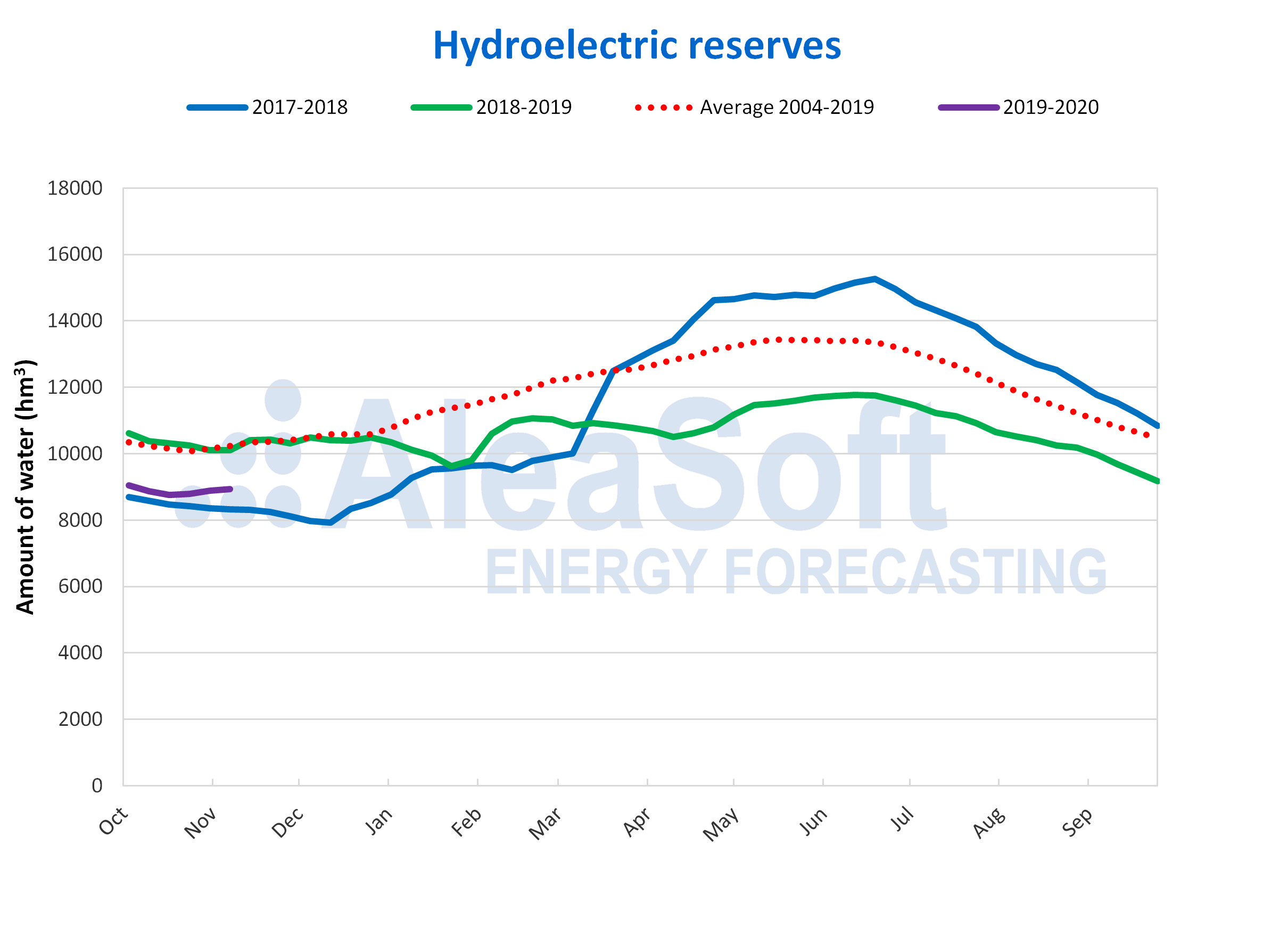AleaSoft, November 6, 2019. The 2018‑2019 hydrological year was dry. For this reason, the hydroelectric energy production fell to below the average of the last fifteen hydrological years. The decline in the hydroelectric energy production contributed to keep electricity market prices high in the hydrological year that ended on September 30. According to the sources consulted by AleaSoft, the first quarter of 2020 is expected to start dry but to end with rainfall above the historical average.
On October 1 began the 2019‑2020 hydrological year in Spain. Reservoirs on that date were at a minimum capacity. This situation is the usual one at this time of the year, as the managers empty the reservoirs to accommodate the water from the autumn rains. But, in addition, in the 2018‑2019 hydrological year that just ended, a drought situation was experienced, the effects of which were felt on the hydroelectric energy production.
Situation of the reservoirs in Spain in the hydrological year 2018‑2019
During the 2018‑2019 hydrological year, the amount of water stored in the hydroelectric reservoirs reached a maximum of 11 763 hm3, corresponding to the week of June 3. This amount was decreasing progressively since June 2019, until a weekly average value of 9180 hm3 was reached at the end of September, which represents the minimum level of this hydrological year. In the whole of the 2018‑2019 hydrological year, the average value corresponding to the amount of water stored in the swamps was 10 645 hm3.

Source: Prepared by AleaSoft using data from the Ministry for Ecological Transition.
In the whole of the last 15 hydrological years in Spain, the average level of water stored in the hydroelectric reservoirs was 11 765 hm3. Thus, the average of the last hydrological year is 1120 hm3 below the historical average.
Regarding the maximum weekly average of the last 15 hydrological years, it was 16 103 hm3 and it was recorded in 2016. The maximum value of the last hydrological year is 27% below this historical maximum value.
As for the minimum weekly average value of the last 15 hydrological years, it was 7931 hm3, reached in 2017. This value is 1249 hm3 below the minimum weekly average of the last hydrological year. It should be noted that both the 2016‑2017 hydrological year and the first months of the 2017‑2018 hydrological year were very dry and below‑average rainfall was recorded.

Precipitation and hydroelectric energy production in the hydrological year 2018‑2019
In the recently completed hydrological year there was a drought situation. Although, according to the State Meteorological Agency (AEMET), the month of April 2019 was the second wettest in this century, after April 2008, the lack of rainfall in other months gave rise to a situation of drought in Spain. Thus, the 2018‑2019 hydrological year would be the third driest hydrological year of the 21st century. This contrasts with the fact that the previous hydrological year, 2017‑2018, was humid, with 11% more rainfall than normal.
The drought of the last hydrological year contributed to a decrease in the hydroelectric energy production. On average, during the 2018‑2019 hydrological year, the daily average hydroelectric energy production was 62 GWh. This value is 19% lower than the daily average production of the last 15 hydrological years, of 76 GWh.
The hydroelectric energy production during the 2018‑2019 hydrological year had its minimum daily value on September 8, 2019, with a production of 28 GWh. The day the maximum daily production was recorded was February 4, 2019, reaching 119 GWh. This value is 51% lower than the maximum daily value of 241 GWh corresponding to the last 15 hydrological years, reached on February 17, 2014.
Impact of the drought on the electricity market prices
The decrease in the hydroelectric energy production affects the prices recorded in the electricity market. Although the electricity price also depends on other factors, it has a tendency to increase in the periods in which the hydroelectric energy production decreases. This is due to the fact that this lack of production is supplied by energy from more expensive technologies, such as coal and combined cycle gas turbines.
In the 2018‑2019 hydrological year just completed, this impact of the drought on the electricity market prices was also noticed: even with a 22% fall in the gas price and 23% in the coal price with respect to the previous hydrological year, the market price remained high. This hydrological year, the average price reached was €53.21/MWh, 12.4% higher than the average value of the last 15 years, of €47.36/MWh.

Sources: Prepared by AleaSoft using data from REE and OMIE.
The hydrological year that begins
In the new hydrological year 2019‑2020, the reservoirs levels continued to fall during the first two weeks of October. But, in the second fortnight, the reserve levels began to recover thanks to the rainfall in recent weeks.
According to AEMET and NOAA, it is expected that in the last quarter of 2019 there will be little rainfall on the Mediterranean side, but that it will be somewhat rainier on the west coast of the Iberian Peninsula. Looking ahead to the first quarter of 2020, it could start in general dry. But it could end with rainfall above the historical average.
Source: AleaSoft Energy Forecasting.
